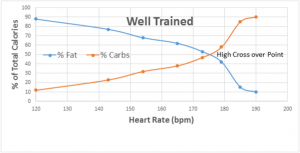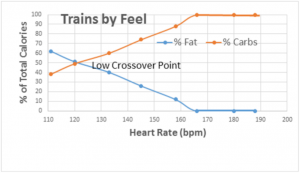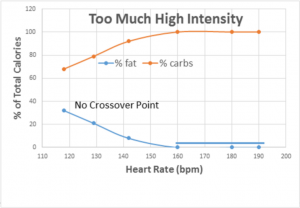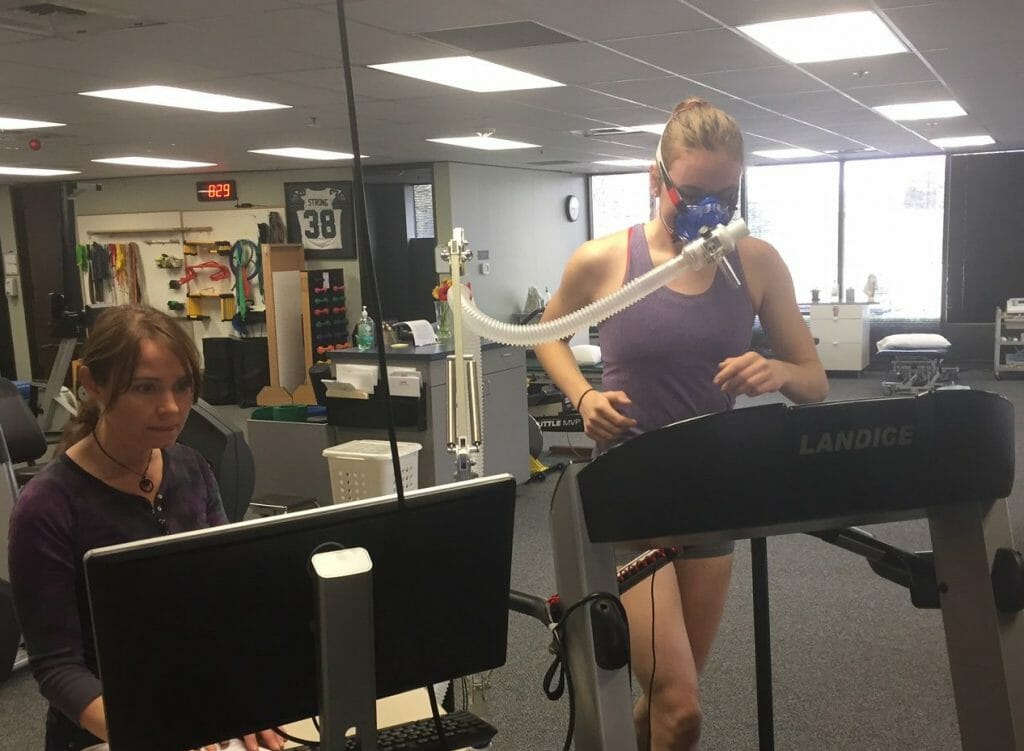Okay, you’ve taken your Metabolic Efficiency Test (MET) or Gas Exchange Test (GET) and gotten your grade. But what does it mean? And where do we go from here?
One advantage to paying professionals to test your blood lactate or metabolic efficiency is that they should explain what the results mean in terms of your training. But for the DIYers out there, or for anyone who felt a little fuzzy on their lab technicians’ explanation of the results, here is a basic look at what your results in these tests might mean. Hopefully by covering some of the basics, along with some of the common results we see and what these types of results imply, we can help you come up with some solid decisions about where to make gains in your training.
Gas Exchange Test Results
In the following three tests, the vertical axis shows the percentage of overall calorie contribution from fats (blue line) and carbs (red line). The horizontal axis is measured in heart rate. Where the lines cross (the Crossover Point) corresponds to where fat and carbs each contribute 50 percent of the total calories. This corresponds very closely to the Aerobic Threshold. It indicates the maximum intensity you can exercise at while fat is still the dominant energy source. This is the maximum capacity of your aerobic system to produce work before becoming overwhelmed by the output of the anaerobic system.
Moving the Crossover Point to the right (improving metabolic efficiency/increasing aerobic capacity) needs to be the first training goal of every endurance athlete.



If you find yourself with test results that look like the first graph, with a high Aerobic Threshold, then you are to be congratulated for your grasp of the most basic and most important of all endurance training principles. You should continue what you have been doing and will probably benefit from the judicious use of higher-intensity training specific to the event you are training for.
If your test looks like a variant of either the second or third graph (low Aerobic Threshold), you have a case of Aerobic Deficiency Syndrome (ADS). Don’t despair. While it can be disappointing to see such a result, there is good news for you: There is a lot of upside potential for you, and with proper training you will respond positively to the training and diet modifications we are going to talk about next. For most folks finding themselves in this predicament, the biggest hurdle to overcome will be a mental one. It is going to require a paradigm shift in the way you view your training. You have arrived in this sorry state by the choices you have made in your approaches to training and possibly your diet.
What to Do If You Are Aerobically Deficient
- Get on a well-designed training plan that targets the development of your aerobic base. This is job number one. This is not rocket science. There are numerous options for these plans and coaching here: Uphill Athlete Training Plans.
- You are going to be much more successful in your training if you have a plan.
- Get a copy of Training for the New Alpinism. Read and comprehend the physiology and methodology chapters. Design your own plan using the book’s guidance.
- At the very least, read the following Uphill Athlete articles for additional information: “David Goettler and Ueli Steck Put Low-Intensity Training to the Test in the Khumbu” | “What Enables Endurance?” | “Train to Burn Fat”
- Do all your aerobic training BELOW your Aerobic Threshold. Yes, this is going to be painfully slow if you have ADS. We know that. You will probably feel like you are wasting your time. How can such low intensity be doing anything for you? We’ve heard it all a hundred times. Bear in mind that you are moving so slowly because that is all the power your puny aerobic system is capable of delivering right now. There’s only one way to improve that: Train high volumes at this low intensity. No amount of high intensity will have the desired effect. In fact, ANY high-intensity training done while trying to increase the aerobic base capacity will negate some of your aerobic base work.
These training methods work, and work very well, as we have documented in hundreds of cases. They require consistency and patience. Below is a before-and-after training comparison of metabolic efficiency from an endurance mountain athlete:


